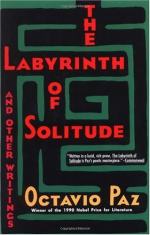
|
| Name: _________________________ | Period: ___________________ |
This test consists of 5 multiple choice questions, 5 short answer questions, and 10 short essay questions.
Multiple Choice Questions
1. Why was unemployment high in Mexico at the time that Paz was writing?
(a) The population grew more quickly than industry.
(b) The two biggest factories were experiencing lay-offs.
(c) The labor unions made it difficult for workers to get jobs.
(d) The economy was going through a recession.
2. What did the Spaniards find when they arrived in South America?
(a) Uneducated, struggling clans.
(b) Autonomous, refined civilizations.
(c) A single ruling power.
(d) Scattered groups of people.
3. How did the Spanish Conquest treat religion?
(a) Spain was defending the faith.
(b) The Conquest did not relate to religion.
(c) Spain was protecting the Mesoamerican religions.
(d) Spain was integrating Mesoamerican religions.
4. Which of the following created the Spanish monarchy?
(a) Violence.
(b) Unity.
(c) Diversity.
(d) Political will.
5. In Paz's argument, how have tradition and religion always been presented to the Mexicans?
(a) As things to be held lightly or discarded.
(b) As things that stifle their individuality.
(c) As things that will solidify their national identity.
(d) As things leading to their spiritual salvation.
Short Answer Questions
1. What did Moctezuma think as the Spaniards approached?
2. Which of the following contributed to making colonialism alive and relevant?
3. According to Paz, what philosophical fact defines much of Mexico's history?
4. What should Mexicans recognize about their alienation from the world?
5. When did Spain begin to lose her hold on Mexico?
Short Essay Questions
1. What is Paz's definition of "community"? How is that definition knowingly idealistic?
2. Why was the Aztec nation able to unify so many diverse tribes? How were they quite skilled with that type of action?
3. Throughout his career, what did Jorge Cuesta argue? What are the benefits and downfalls of his argument?
4. What did Article 3 of the new Constitution mandate? What troubles did that Article cause?
5. Paz asserts that every revolution attempts to restore the order that an oppressor has twisted or disregarded altogether. How was that true in Mexico?
6. How does Paz define "Mexicanism"? How does it mesh with the individual whom he had described earlier?
7. Pulling from the ideas of Jose Gaos, Paz, speaks of the physical duality in Mexico. What does that mean? What significance does that idea have?
8. How did Catholicism reduce the Indian converts into passive believers? How was that a significant blow?
9. What role did Catholicism play in the lives of the conquering Spaniards? Was that role contradictory?
10. What happened when Spanish America separated itself from Spain? Given what Paz has stated throughout the book about that moment in history, draw your own conclusions about why that happened.
|
This section contains 1,931 words (approx. 7 pages at 300 words per page) |

|




